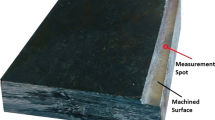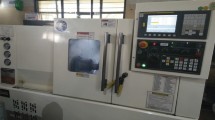The main elements of the working surface of the diamond wheel after grinding Al2O3–TiC-ceramics are revealed and their parameters are investigated. Using the developed technique, topographic maps, projections of grains, and transverse and integral profiles for the selected sections of the working surface of the diamond wheel were constructed. A method is proposed for predicting the quality of a polished ceramic surface, based on a statistical assessment of the characteristics of the integral profile of the working surface of a diamond wheel.






Similar content being viewed by others
References
Zhu Rupeng, He Ning, Fu Yucan, Yang Changyong, “Experimental research on grinding surface waviness of engineering ceramics,” Materials Science Forum Advances in Materials Manufacturing Science and Technology XV, 770, 175 – 178 (2014).
L. Tanovic, P. Bojanic, and M. Popovic, “Mechanisms in oxide-carbide ceramic BOK60 grinding,” Int. J. Adv. Manuf. Tech., 58, 9 – 12 (2011).
V. V. Kuzin, “Effective use of high-density ceramic for manufacture of cutting and working tools,” Refract. Ind. Ceram., 51, No. 6, 421 – 426 (2010).
Yoshifumi Ohbuchi, Tetsuo Matsuo, and Noboru Ueda, “Warp in high precision cut-off grinding of Àl2Î3 – TiC ceramic thin plate,” CIRP Annals — Manufacturing Technology, 48, 285 – 288 (1999).
V. Kuzin, “A model of forming the surface layer of ceramic parts based on silicon nitride in the grinding process,” Key Eng. Mater. Precision Machining., 496, 127 – 131 (2012).
Yuki Yamamoto, Heiji Yasui, Yusuke Tanaka, Ryushiro Sakamoto, et al., “Investigation on high depth of cut of ultrasmoothness grinding of Al2O3 – TiC ceramic,” Proc. ASPE 2007 Annual Meeting, 394 – 397 (2007).
V. V. Kuzin, “Technological aspects of diamond grinding of the nitride ceramics,” Russ. Eng. Res., 24(1), 23 – 28 (2004).
B. Zhang, X. L. Zheng, H. Tokura, and M. Yoshikawa, “Grinding induced damage in ceramics,” J. Mater. Process. Technol., 132, 353 – 364 (2003).
V. V. Kuzin, S. N. Grigor’ev, and S. Yu. Fedorov, “Correlation of Al2O3-ceramic structure with the mechanism of surface layer formation for workpieces during diamond grinding,” Refract. Ind. Ceram., 60(1), 82 – 85 (2019).
T. Matsuo, M. Touge, and H. Yamada, “High-precision surface grinding of ceramics with superfine grain diamond cup wheels,” CIRP Annals –— Manufacturing Technology, 46, 249 – 252 (1997).
I. L. Shkarupa and D. A. Klimov, “Mechanical treatment of ceramic materials based on aluminum oxide, silicon nitride and silicon carbide” [in Russian], Steklo i Keramika, No. 6, 16 – 18 (2004).
V. V. Kuzin and S. Yu. Fedorov, “Correlation of diamond grinding regimes with Al2O3 – TiC-ceramic surface condition,” Refract. Ind. Ceram., 57(5), 520 – 525 (2017).
V. A. Rogov and M. I. Shkarupa, “Comparative analysis of mechanical processing of superhard ceramic materials by grinding” [in Russian], Tekhnologiya Mashinostroeniya, No. 5 (83), 12 – 16 (2009).
V. V. Kuzin, S. Yu. Fedorov, and S. N. Grigor’ev, “Features of Al2O3 – TiC-ceramic specimen edge morphology formation during diamond grinding,” Refract. Ind. Ceram., 58(3), 319 – 323 (2017).
V. Kuzin, S. Grigoriev, S. Fedorov, and M. Fedorov, “Surface defects formation in grinding of silicon nitride ceramics,” Appl. Mech. Mater., 752/753, 402 – 406 (2015).
S. N. Grigoriev and V. V. Kuzin, “Prospects for tools with ceramic cutting plates in modern metal working,” Glass Ceram., 68(7/8), 253 – 257 (2011).
V. V. Kuzin, M. R. Portnoi, and S. Yu. Fedorov, “Stress inhomogeneity in oxide-carbide ceramic surface with developed relief under action of heat flow,” Refract. Ind. Ceram., 56(5), 557 – 560 (2016).
Acknowledgement
This work is funded within the framework of the state assignment of the Ministry of Science and Higher Education of the Russian Federation, Project No. 0707-2020-0025.
Author information
Authors and Affiliations
Corresponding author
Additional information
Translated from Novye Ogneupory, No. 11, pp. 64 – 70, November, 2020.
Rights and permissions
About this article
Cite this article
Kuzin, V.V., Grigoriev, S.N. & Volosova, M.A. Relationship of the Profile of the Working Surface of a Diamond Wheel with the Quality of the Grinded Surface of Al2O3–TiC-Ceramics. Refract Ind Ceram 61, 684–690 (2021). https://doi.org/10.1007/s11148-021-00543-2
Received:
Published:
Issue Date:
DOI: https://doi.org/10.1007/s11148-021-00543-2




